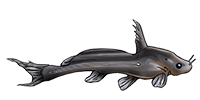This is no different than dozens of genera...
Larry,
It is very, very different as those genera show contiguous distribution. Several loricariids demonstrate this between major drainages:
Otocinclus, and
Rineloricaria are good examples of genera distributed through both the Amazon and Orinoco drainages. As are many of the genera you mention above like
Apistogramma.
If we go a step back we find even older loricariid groups that are still present in drainages that were cut off from the main Amazon drainage (circa 10 million years ago) like
Panaque,
Hypostomus,
Loricaria, and
Chaetostoma. These old genera were present when the Amazon/Orinoco sea was one body of water. We know that
Corydoras, for example, did not exist that far back as they are absent from all drainages cut off from the proto-Amazon by the rise of the Andes. There are no
Corydoras in the Magdalena drainage, Maracaibo drainage, or west of the Andes. Therefore we know they are "new" in an evolutionary sense.
As comparison, because I know you are a cichlid guy, cichlid genera found are
Aequidens (aka
Acara),
Geophagus, and
Petenia (aka
Cichlosoma). Every modern Amazonian cichlid genera likely evolved from one of these original genera. So we know
Apistogramma likely did not exist 10 million years ago, but it had evolved by the time the Orinoco separated from the Amazon (since it is found in both).
For the
Hypancistrus of the Orinoco/upper Negro to be congeners with those of the Xingu, I believe we should see a contiguous distribution of the genus
Hypancistrus between the two areas like we see with
Farlowella,
Ancistrus, or
Loricaria. We don't though. That may be because we lack that data (Milton's postion) or because they are not actually congeners and just demonstrate some shared evolutionary traits.
-Shane
"My journey is at an end and the tale is told. The reader who has followed so faithfully and so far, they have the right to ask, what do I bring back? It can be summed up in three words. Concentrate upon Uganda."
Winston Churchill, My African Journey








/g/s/1.jpg)



